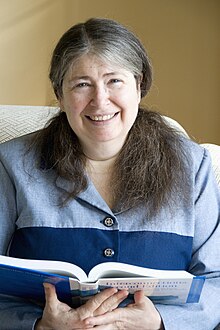Radia Perlman
| Radia Perlman | |
|---|---|
 |
|
| Born | 1951 (age 65–66) Portsmouth, Virginia, US |
| Nationality | United States |
| Fields | Computer Science |
| Institutions | Intel |
| Alma mater | MIT |
| Thesis | Network layer protocols with Byzantine robustness (1988) |
| Doctoral advisor | David D. Clark |
| Known for | Network and security protocols; computer books |
Radia Joy Perlman (born January 1, 1951) is a software designer and network engineer. She is most famous for her invention of the (STP), which is fundamental to the operation of network bridges, while working for Digital Equipment Corporation. She also made large contributions to many other areas of network design and standardization, such as , including TRILL, which she invented to correct some of the shortcomings of spanning-trees.
She is currently employed by Dell EMC.
As an undergraduate at MIT she undertook a UROP (Undergraduate Research Opportunity), in lieu of course units, within the LOGO Lab at the (then) MIT Artificial Intelligence Laboratory. Working under the supervision of Seymour Papert, she developed a child-friendly version of the educational robotics language LOGO, called TORTIS ("Toddler's Own Recursive Turtle Interpreter System"). During research performed in 1974–6, young children—the youngest aged 3½ years, programmed a LOGO educational robot called a Turtle. Radia has been described as a pioneer of teaching young children computer programming.
Perlman obtained a Bachelor's, Master's in Mathematics, and a Ph.D. in Computer Science from MIT in 1988. Her doctoral thesis at MIT addressed the issue of routing in the presence of malicious network failures.
She is most famous for her invention of the (STP), which is fundamental to the operation of network bridges, while working for Digital Equipment Corporation. She also made large contributions to many other areas of network design and standardization, such as , including TRILL, which she invented to correct some of the shortcomings of spanning-trees. She is sometimes referred to as the "Mother of the Internet", a title which she dislikes.
Her work transformed the Ethernet protocol from using a few nodes over a limited distance, into something able to create large networks.
...
Wikipedia
